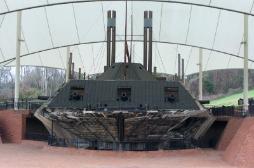


Wreck of the U.S.S. Cairo
One of the most remarkable
artifacts in Vicksburg is the
wreck of the Civil War ironclad
U.S.S. Cairo. The gunboat is
now part of the national park.
One of the most remarkable
artifacts in Vicksburg is the
wreck of the Civil War ironclad
U.S.S. Cairo. The gunboat is
now part of the national park.
The Deck of the Cairo
The guns of the U.S.S. Cairo
are still in place and visitors
can step onto the deck of the
historic warship.
The guns of the U.S.S. Cairo
are still in place and visitors
can step onto the deck of the
historic warship.
U.S.S. Cairo at Vicksburg, Mississippi
ExploreSouthernHistory.com - U.S.S. Cairo at Vicksburg, Mississippi
ExploreSouthernHistory.com - U.S.S. Cairo at Vicksburg, Mississippi
Vicksburg's Civil War Ironclad
One of the most striking artifacts to be found
at Vicksburg National Military Park is also the
largest.
The U.S.S. Cairo, a noted Civil War ironclad,
is now preserved as part of a special display
on the northern edge of the battlefield. Once
a powerful Union vessel, she is remarkably
well preserved and offers visitors a unique
opportunity to actually step aboard a warship
that is more than 140 years old.
A "super weapon" of her time, the Cairo was
constructed as part of a plan by the Union to
develop a flotilla of ironclad gunboats that
would be used as both defensive and
offensive weapons on the Mississippi and
Ohio Rivers.
More powerful than anything then afloat on
the interior rivers, these seven vessels
helped change the tide of the war in the
Mississippi valley.
Constructed at Mound City, Illinois, and
commissioned in January of 1862, the Cairo
saw action at the Battles of Plum Point and
Memphis. In the latter action, she helped
devastate the Confederate river fleet in a
battle that was as stunning to Southern
hopes as it was destructive to the
Confederacy's fleet.
As Union authorities cast their sights down
the Mississippi, they realized that the Yazoo
River just north of Vicksburg played a vital
role in the city's defense. The river had been
fortified by the Confederates and plans to
take Vicksburg from the north necessitated a
clearing of Southern opposition from the
Yazoo.
On December 12, 1862, the Cairo was sent
up the Yazoo River. As the flotilla reached a
point seven miles north of Vicksburg,
Confederate artillery batteries opened fire.
The captain of the Cairo was Lieutenant
Commander Thomas Selfridge, Jr. He
ordered his men to clear for action and
turned the ironclad to engage the Southern
cannon. He had no way of knowing that the
Confederates had anticipated a naval attack
and had planned for it. "Torpedoes" (what we
now call mines) had been placed in the
Yazoo.
As the ironclad turned to open fire on the
Confederate shore batteries, electric charges
were sent down the wires connecting the
mines to shore and two massive explosions
lifted the Cairo from the water.
Water poured into the ironclad, but almost
miraculously the officers and crews did not
panic but instead evacuated the vessel with
no lives lost. She sank to the bottom of the
river in just twelve minutes, the first warship
in history to be sunk by an electronic mine.
The disaster proved critical and the Union
expedition up the Yazoo ended in defeat.
at Vicksburg National Military Park is also the
largest.
The U.S.S. Cairo, a noted Civil War ironclad,
is now preserved as part of a special display
on the northern edge of the battlefield. Once
a powerful Union vessel, she is remarkably
well preserved and offers visitors a unique
opportunity to actually step aboard a warship
that is more than 140 years old.
A "super weapon" of her time, the Cairo was
constructed as part of a plan by the Union to
develop a flotilla of ironclad gunboats that
would be used as both defensive and
offensive weapons on the Mississippi and
Ohio Rivers.
More powerful than anything then afloat on
the interior rivers, these seven vessels
helped change the tide of the war in the
Mississippi valley.
Constructed at Mound City, Illinois, and
commissioned in January of 1862, the Cairo
saw action at the Battles of Plum Point and
Memphis. In the latter action, she helped
devastate the Confederate river fleet in a
battle that was as stunning to Southern
hopes as it was destructive to the
Confederacy's fleet.
As Union authorities cast their sights down
the Mississippi, they realized that the Yazoo
River just north of Vicksburg played a vital
role in the city's defense. The river had been
fortified by the Confederates and plans to
take Vicksburg from the north necessitated a
clearing of Southern opposition from the
Yazoo.
On December 12, 1862, the Cairo was sent
up the Yazoo River. As the flotilla reached a
point seven miles north of Vicksburg,
Confederate artillery batteries opened fire.
The captain of the Cairo was Lieutenant
Commander Thomas Selfridge, Jr. He
ordered his men to clear for action and
turned the ironclad to engage the Southern
cannon. He had no way of knowing that the
Confederates had anticipated a naval attack
and had planned for it. "Torpedoes" (what we
now call mines) had been placed in the
Yazoo.
As the ironclad turned to open fire on the
Confederate shore batteries, electric charges
were sent down the wires connecting the
mines to shore and two massive explosions
lifted the Cairo from the water.
Water poured into the ironclad, but almost
miraculously the officers and crews did not
panic but instead evacuated the vessel with
no lives lost. She sank to the bottom of the
river in just twelve minutes, the first warship
in history to be sunk by an electronic mine.
The disaster proved critical and the Union
expedition up the Yazoo ended in defeat.

| The U.S.S. Cairo at Vicksburg The beautifully preserved wreck is now the centerpiece of a fascinating museum that interprets the history and recovery of the Civil War ironclad. |
Vicksburg did eventually fall, but the Cairo
remained on the bottom of the river for a
century. A footnote to the Vicksburg
Campaign, she was all but forgotten.
In the 1960s, however, a massive effort was
undertaken to salvage the vessel after it was
realized that she was still largely intact and
buried in the mud on the bottom of the Yazoo.
The enormous size and weight of the Cairo
prevented her from being raised in one
piece, so she was cut into three sections and
brought to the surface in pieces. The three
sections were then carried to the Ingalls
Shipyard in Pascagoula, where the wreck
was carefully cleaned and preserved.
In 1977, Cairo was moved to Vicksburg
National Military Park as an outdoor exhibit.
Since then, she has been the focus of a
major preservation effort and is now the
centerpiece of an outstanding museum
complex within the national park.
Walkways provide visitors with the extremely
rare chance to actually step aboard a real
Civil War ironclad. The cannon are still in
place and visitors and the points where the
mines exploded are clearly visible.
The adjacent museum displays scores of
artifacts recovered from the vessel when she
was raised from the Yazoo. The museum
also offers a wealth of information on the
ironclad and on the role of the U.S. Navy in
the Vicksburg Campaign. The towering U.S.
Navy monument can be seen on the bluff just
above the museum.
The U.S.S. Cairo is adjacent to Vicksburg
National Cemetery and is on the primary tour
road in the National Military Park. It can be
visited during normal park hours
remained on the bottom of the river for a
century. A footnote to the Vicksburg
Campaign, she was all but forgotten.
In the 1960s, however, a massive effort was
undertaken to salvage the vessel after it was
realized that she was still largely intact and
buried in the mud on the bottom of the Yazoo.
The enormous size and weight of the Cairo
prevented her from being raised in one
piece, so she was cut into three sections and
brought to the surface in pieces. The three
sections were then carried to the Ingalls
Shipyard in Pascagoula, where the wreck
was carefully cleaned and preserved.
In 1977, Cairo was moved to Vicksburg
National Military Park as an outdoor exhibit.
Since then, she has been the focus of a
major preservation effort and is now the
centerpiece of an outstanding museum
complex within the national park.
Walkways provide visitors with the extremely
rare chance to actually step aboard a real
Civil War ironclad. The cannon are still in
place and visitors and the points where the
mines exploded are clearly visible.
The adjacent museum displays scores of
artifacts recovered from the vessel when she
was raised from the Yazoo. The museum
also offers a wealth of information on the
ironclad and on the role of the U.S. Navy in
the Vicksburg Campaign. The towering U.S.
Navy monument can be seen on the bluff just
above the museum.
The U.S.S. Cairo is adjacent to Vicksburg
National Cemetery and is on the primary tour
road in the National Military Park. It can be
visited during normal park hours

Ironclad of the Mississippi
Sections of the armor of the
Cairo have been restored to
help visitors see the ironclad
as she originally appeared.
Sections of the armor of the
Cairo have been restored to
help visitors see the ironclad
as she originally appeared.



Return to the Vicksburg Main Page
Historic Sites in Mississippi
Explore other Southern Historic Sites
Also of Interest...
National Civil War Navy Museum
Historic Sites in Mississippi
Explore other Southern Historic Sites
Also of Interest...
National Civil War Navy Museum



Custom Search
| Copyright 2011 by Dale Cox All rights reserved. |